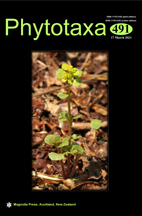Abstract
Austropleospora is a genus of Didymosphaeriaceae with only three extant species. A survey of saprobic ascomycetes in Guizhou Province, China, discovered a new Austropleospora species on dead twigs in a terrestrial habitat. The molecular phylogeny based on a combined SSU-LSU-tef1-ITS DNA sequence dataset confirmed the new species’ taxonomic position in Austropleospora. Austropleospora ochracea sp. nov. is characterized by globose to subglobose and uni-loculate ascoma with a centric short papilla, brown to dark brown peridium with cells of textura angularis to textura prismatica and conical, comparatively smaller ascospores with narrowly rounded polar ends. The new taxon is compared with similar species in Austropleospora, and its taxonomic status is briefly discussed.

